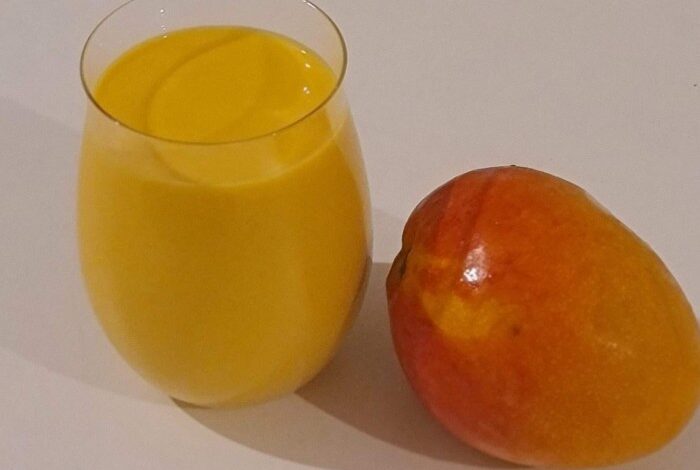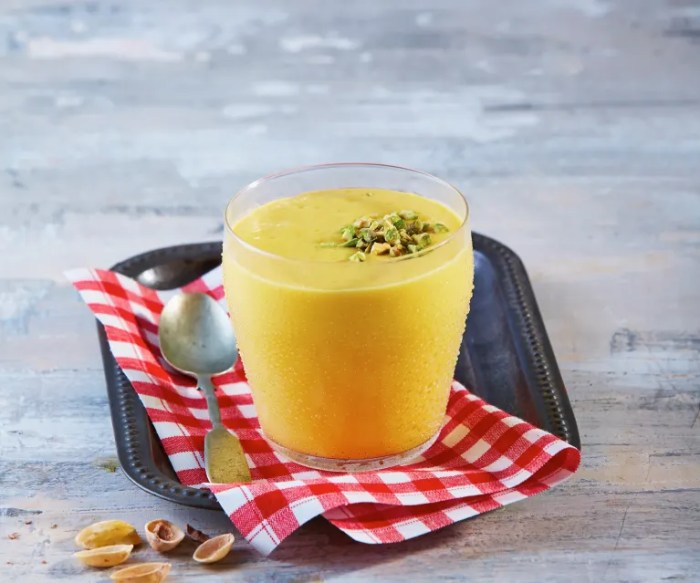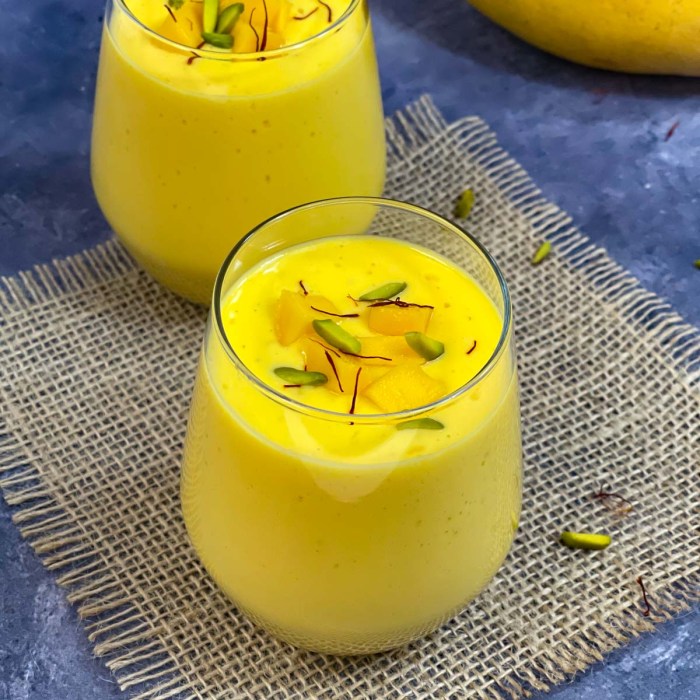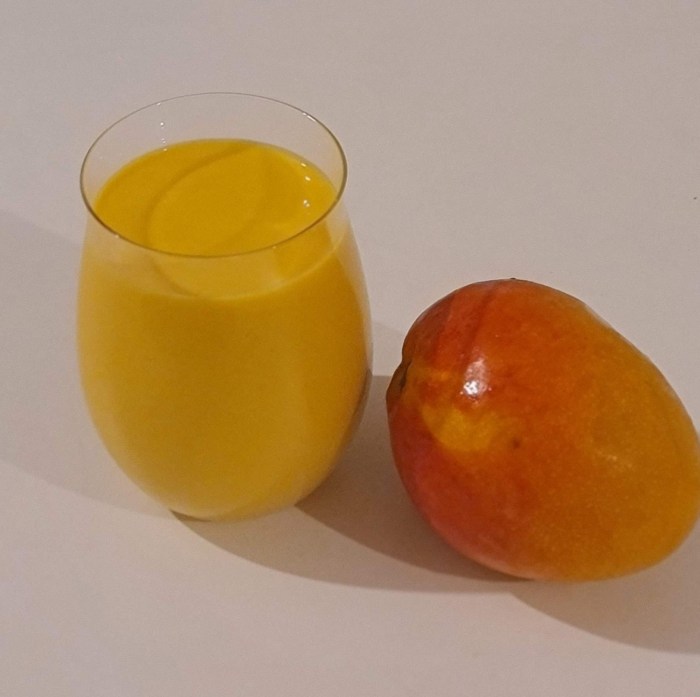
Restaurant Style Mango Lassi: A Delicious Twist on Tradition
Restaurant Style Mango Lassi: A Delicious Twist on Tradition – Mango lassi, a beloved Indian beverage, has been enjoyed for centuries. This refreshing blend of yogurt, mango, and spices is a staple in many Indian households and restaurants.
But, restaurant-style mango lassi takes this classic drink to a whole new level. It often features unique flavor combinations, creamy textures, and eye-catching presentations. This blog post will delve into the world of restaurant-style mango lassi, exploring its variations, ingredients, techniques, and cultural significance.
From its origins in ancient India to its modern-day popularity around the globe, mango lassi has evolved into a culinary masterpiece. Restaurant chefs have taken this traditional drink and transformed it into a flavorful experience that tantalizes taste buds and delights the senses.
We’ll uncover the secrets behind the distinctive taste and texture of restaurant-style mango lassi, highlighting the key ingredients and techniques that set it apart.
Introduction to Mango Lassi

Mango lassi, a refreshing and flavorful beverage, has become a beloved staple in South Asian cuisine. This creamy drink combines the sweetness of ripe mangoes with the tanginess of yogurt, creating a perfect balance of flavors.Mango lassi’s origins can be traced back to the Indian subcontinent, where it has been enjoyed for centuries.
The history of lassi itself dates back to ancient times, with early versions likely consisting of yogurt mixed with water or spices. The addition of mangoes, a fruit native to South Asia, is believed to have emerged later, likely during the Mughal era.
Traditional Ingredients and Preparation
Traditional mango lassi is made with simple, wholesome ingredients:
- Ripe mangoes:The key ingredient, ripe mangoes provide the sweet and aromatic flavor.
- Yogurt:Typically plain, unsweetened yogurt provides the tangy and creamy texture.
- Water:Used to adjust the consistency and create a smooth drink.
- Sugar:Optional, but often added to enhance sweetness.
- Spices:Cardamom, saffron, or a pinch of black pepper can be added for an extra layer of flavor.
The preparation method is straightforward. Ripe mangoes are peeled, pitted, and blended with yogurt, water, and sugar (if desired). Spices can be added during blending or as a garnish. The resulting mixture is chilled and served in tall glasses, often garnished with chopped mango pieces or a sprinkle of cardamom.
Popularity and Cultural Significance
Mango lassi has gained immense popularity across the globe, becoming a favorite beverage in South Asia, the Middle East, and other regions. It is commonly enjoyed as a refreshing drink on hot days, a healthy snack, or a dessert. Mango lassi holds significant cultural importance in South Asia.
It is often served at weddings, festivals, and other special occasions. In India, mango lassi is particularly popular during the summer months, when mangoes are in season. It is also considered a traditional drink in Pakistan, Bangladesh, and Nepal.
“Mango lassi is a testament to the culinary ingenuity of South Asia, combining simple ingredients into a flavorful and refreshing beverage that has captured the hearts of people around the world.”
Restaurant Style Mango Lassi Variations
While the basic mango lassi recipe remains consistent, restaurants often introduce variations to enhance flavor and create unique experiences. These variations are not just about adding different ingredients but also about mastering techniques that elevate the lassi from a simple drink to a culinary masterpiece.
Flavor Profiles and Toppings
Restaurant-style mango lassi often features unique flavor profiles and toppings that add depth and complexity.
I’m always craving a refreshing restaurant-style mango lassi after a hearty meal. It’s the perfect way to cleanse the palate and cool down. Speaking of hearty meals, I recently discovered a fantastic recipe for instant pot chicken tortilla soup that’s both flavorful and easy to make.
The creamy texture and blend of spices are just as satisfying as the mango lassi, but in a completely different way! So, next time I’m craving a delicious and comforting soup, I’ll be whipping up this instant pot recipe, and then finishing off with a cool and refreshing mango lassi for the perfect meal.
- Spiced Mango Lassi:A dash of cardamom, cinnamon, or nutmeg adds a warm and aromatic dimension to the mango flavor. This variation is particularly popular in North Indian restaurants.
- Rose-infused Mango Lassi:A hint of rose water adds a delicate floral fragrance and a touch of sweetness. This variation is often found in restaurants that specialize in Persian or Middle Eastern cuisine.
- Sweet and Spicy Mango Lassi:A blend of sweet mango puree with a touch of chili powder or black pepper creates a tantalizing contrast of flavors. This variation is particularly popular in South Indian restaurants.
- Mango Lassi with Cream or Yogurt:Adding a dollop of fresh cream or thick yogurt enhances the richness and texture of the lassi, creating a creamy and indulgent experience. This variation is often found in restaurants that serve a variety of desserts.
- Toppings:Restaurants often elevate the lassi with toppings like chopped pistachios, almonds, or a drizzle of honey. These toppings add a visual appeal and a delightful crunch to the drink.
Techniques and Ingredients
Restaurant-style mango lassi often uses techniques and ingredients that differentiate it from home-made versions.
A creamy, refreshing mango lassi is the perfect way to cool down after a spicy meal. Speaking of spicy, I recently tried a recipe for chef johns chicken under a brick that had me sweating! The intense flavor of the chicken was perfectly balanced by the cool, sweet mango lassi.
It’s a winning combination that I’ll definitely be repeating!
- Blending Technique:Restaurants often use high-powered blenders to achieve a smooth and velvety texture. The prolonged blending time ensures that the mango puree is completely broken down, resulting in a consistent and creamy lassi. This technique is particularly important for restaurant-style lassis, as they are often served in larger quantities.
- Fresh Mango Puree:Restaurants often use fresh mango puree, which is made by blending ripe mangoes with a little sugar or honey. This ensures that the lassi has a vibrant mango flavor and a natural sweetness. This approach differs from home-made versions where frozen mango pulp or commercially available mango nectar is often used.
- Chilled Ingredients:Restaurants often chill all the ingredients before blending, ensuring a refreshing and cool lassi. This is especially important in warmer climates where the lassi needs to be served chilled to be enjoyed.
Ingredients and Techniques
Restaurant-style mango lassi, a popular Indian beverage, is a delicious blend of sweet, tangy, and refreshing flavors. This drink is a perfect balance of creamy yogurt, ripe mangoes, and a touch of sweetness, all blended together to create a smooth and satisfying treat.
Let’s delve into the essential ingredients and techniques that make this lassi a crowd-pleaser.
Ingredients
The core ingredients of a restaurant-style mango lassi contribute significantly to its flavor and texture. These ingredients are carefully selected and measured to achieve the perfect balance of sweet, tangy, and creamy notes.
I love the creamy, sweet, and tangy kick of a restaurant-style mango lassi. It’s a perfect balance of flavors and textures, especially after a spicy meal. Speaking of delicious contrasts, I recently tried a recipe for eggplant caponata sicilian version that had the most amazing blend of sweet and savory notes.
I think a mango lassi would be a fantastic pairing for the caponata, offering a cool and refreshing counterpoint to the dish’s richness.
- Mangoes:The star ingredient, ripe mangoes are the heart of the lassi. They provide the sweetness and fruity flavor. Using ripe mangoes ensures a rich and smooth texture, while the natural sweetness adds a delightful touch to the drink.
- Yogurt:This ingredient adds the tangy element and creamy texture.
It is typically used plain and unsweetened, allowing the mango flavor to shine through. Full-fat yogurt is often preferred for its richer taste and texture, but low-fat yogurt can also be used.
- Milk:Milk is added for dilution and to enhance the creaminess of the lassi.
Whole milk is preferred for a richer and more satisfying texture.
- Sugar:While mangoes provide some natural sweetness, sugar is often added to adjust the sweetness level. This is typically done to taste, allowing individuals to customize the sweetness according to their preference.
- Cardamom Powder:A pinch of cardamom powder adds a subtle warmth and aroma to the lassi. It complements the mango flavor and adds an extra layer of complexity to the drink.
- Salt:A small pinch of salt enhances the flavors and balances the sweetness.
This is a subtle ingredient but plays a significant role in rounding out the taste profile.
Blending Techniques
Restaurants often use high-powered blenders to create a smooth and consistent mango lassi. The blending technique plays a crucial role in achieving the desired texture.
- Pre-Preparation:Mangoes are typically peeled, pitted, and chopped into smaller pieces before blending. This ensures smooth blending and avoids large chunks in the final product.
- Blending Process:The chopped mangoes, yogurt, milk, sugar, cardamom powder, and salt are added to the blender.
The ingredients are then blended on high speed until smooth and creamy. The blending time may vary depending on the power of the blender and the desired consistency.
- Consistency Control:The consistency of the lassi can be adjusted by adding more milk or yogurt.
For a thicker lassi, use less milk. For a thinner lassi, add more milk.
Presentation and Serving
A well-presented mango lassi is an integral part of the dining experience. The right glassware, garnishes, and accompanying elements elevate the visual appeal and enhance the overall enjoyment.
Glassware and Garnishes
The choice of glassware significantly influences the visual presentation of the mango lassi. Tall, slender glasses, such as highball glasses or hurricane glasses, are ideal for showcasing the vibrant color and layering of the lassi. The wide mouth allows for easy access and sipping.Here’s a table illustrating different presentation styles for mango lassi:| Presentation Style | Glassware | Garnishes ||—|—|—|| Classic | Highball glass | A sprinkle of cardamom powder, a fresh mint sprig, or a slice of mango || Contemporary | Hurricane glass | A swirl of whipped cream, a drizzle of honey, or a mango slice garnish || Festive | Martini glass | A rim of sugar, a mango slice, and a sprig of mint || Layered | Tall glass | A layer of mango puree, followed by a layer of yogurt, and topped with a sprinkle of chopped pistachios |Garnishes add a touch of elegance and enhance the flavor profile.
Common garnishes include:* Fresh mint leaves:Add a refreshing and aromatic touch.
Cardamom powder
Enhances the sweetness and provides a warm, earthy flavor.
Mango slices
Provide a burst of fresh mango flavor.
Whipped cream
Adds a creamy texture and visual appeal.
Chopped pistachios
Offer a nutty crunch and visual contrast.
Accompanying Foods and Beverages
Mango lassi pairs well with a variety of foods and beverages. * Accompanying Foods:Mango lassi complements savory dishes like samosas, pakoras, and vegetable curries. Its sweet and tangy flavor provides a refreshing contrast to spicy foods.
Accompanying Beverages
Mango lassi can be served alongside other beverages like chai, coffee, or even a light fruit juice.
Health and Nutritional Aspects: Restaurant Style Mango Lassi

Mango lassi, a beloved Indian beverage, is not only a delicious treat but also a source of various nutrients. Its blend of mango, yogurt, and sometimes spices offers a unique combination of vitamins, minerals, and antioxidants.
Nutritional Benefits of Mango Lassi
Mango lassi is a rich source of essential nutrients, including vitamins A, C, and K, as well as minerals like potassium, calcium, and magnesium. Mango, the star ingredient, is packed with vitamin C, a potent antioxidant that helps boost the immune system and protect against cell damage.
Yogurt, another key component, is a good source of calcium, which is essential for strong bones and teeth. Yogurt also contains probiotics, beneficial bacteria that support gut health.
Potential Health Benefits and Drawbacks
Regular consumption of mango lassi can offer several potential health benefits. The antioxidants in mango may help reduce the risk of chronic diseases like heart disease and cancer. The probiotics in yogurt can aid digestion and improve gut health. However, there are also potential drawbacks to consider.
Mango lassi is high in sugar, and excessive consumption can contribute to weight gain and other health issues. Individuals with lactose intolerance may experience digestive discomfort after consuming mango lassi.
Comparison of Restaurant-Style and Homemade Mango Lassi
Restaurant-style mango lassi often contains added sugar, artificial flavors, and preservatives, which can significantly impact its nutritional profile. Homemade versions, on the other hand, are typically made with fresh ingredients and less sugar, making them a healthier option.
A homemade mango lassi made with fresh mango, plain yogurt, and a touch of honey offers a balanced and nutritious drink.
Restaurant-style mango lassi may also contain higher amounts of fat and calories due to the use of full-fat yogurt and other ingredients. Homemade versions can be made with low-fat yogurt or even plant-based alternatives to reduce the fat content.
Mango Lassi in Modern Cuisine

Mango lassi, a beloved Indian beverage, has transcended its traditional roots and found its way into the contemporary culinary landscape. It’s no longer just a refreshing drink but an ingredient that adds a unique twist to modern dishes, showcasing the versatility and adaptability of this classic.
Mango Lassi’s Role in Fusion Cuisine
Mango lassi’s creamy texture and vibrant sweetness make it a perfect complement to a wide range of flavors and cuisines. Fusion chefs are incorporating mango lassi into innovative dishes, creating unexpected flavor combinations and elevating the dining experience.
- Mango Lassi-Infused Marinades:Chefs are using mango lassi as a marinade for meats and seafood, adding a tangy and aromatic element to the dish. The lactic acid in the lassi helps tenderize the protein, while the mango flavor infuses the meat with a unique sweetness.
- Mango Lassi Soups and Sauces:Mango lassi can be incorporated into soups and sauces, adding a creamy, tangy, and fruity dimension. This can be seen in dishes like mango lassi-based curries, creamy tomato soups with a mango lassi swirl, and even vegan cheese sauces.
- Mango Lassi Desserts:Mango lassi is finding its way into desserts, creating innovative and refreshing treats. Examples include mango lassi panna cotta, mango lassi ice cream, and mango lassi cheesecakes.
Examples of Innovative Recipes, Restaurant style mango lassi
Here are some examples of how chefs are using mango lassi to create innovative and delicious dishes:
- Mango Lassi-Marinated Grilled Chicken with Cilantro-Mint Chutney:This dish combines the tangy sweetness of mango lassi with the savory flavors of cilantro-mint chutney, creating a balanced and flavorful meal.
- Mango Lassi Panna Cotta with Toasted Coconut:This dessert is a delightful combination of creamy panna cotta, the refreshing sweetness of mango lassi, and the nutty crunch of toasted coconut.
- Mango Lassi-Glazed Salmon with Roasted Vegetables:This dish features salmon glazed with a sweet and tangy mango lassi sauce, creating a unique and flavorful combination.
Mango Lassi’s Influence on Culinary Trends
Mango lassi’s growing popularity in modern cuisine is a testament to its versatility and potential to inspire new trends and flavor combinations. Its unique blend of sweetness, tanginess, and creaminess offers a refreshing alternative to traditional culinary elements, encouraging chefs to explore new boundaries in flavor profiles and culinary techniques.
“Mango lassi is a versatile ingredient that can be used in a variety of ways to create unique and delicious dishes. Its creamy texture, vibrant sweetness, and tangy flavor make it a perfect complement to a wide range of cuisines.”
Chef [Name], [Restaurant Name]
Mango lassi’s journey from a traditional Indian beverage to a contemporary culinary ingredient highlights the evolving nature of food trends and the global influence of diverse cuisines. Its ability to seamlessly blend with various flavors and culinary techniques makes it a valuable tool for chefs seeking to create innovative and exciting dishes.





